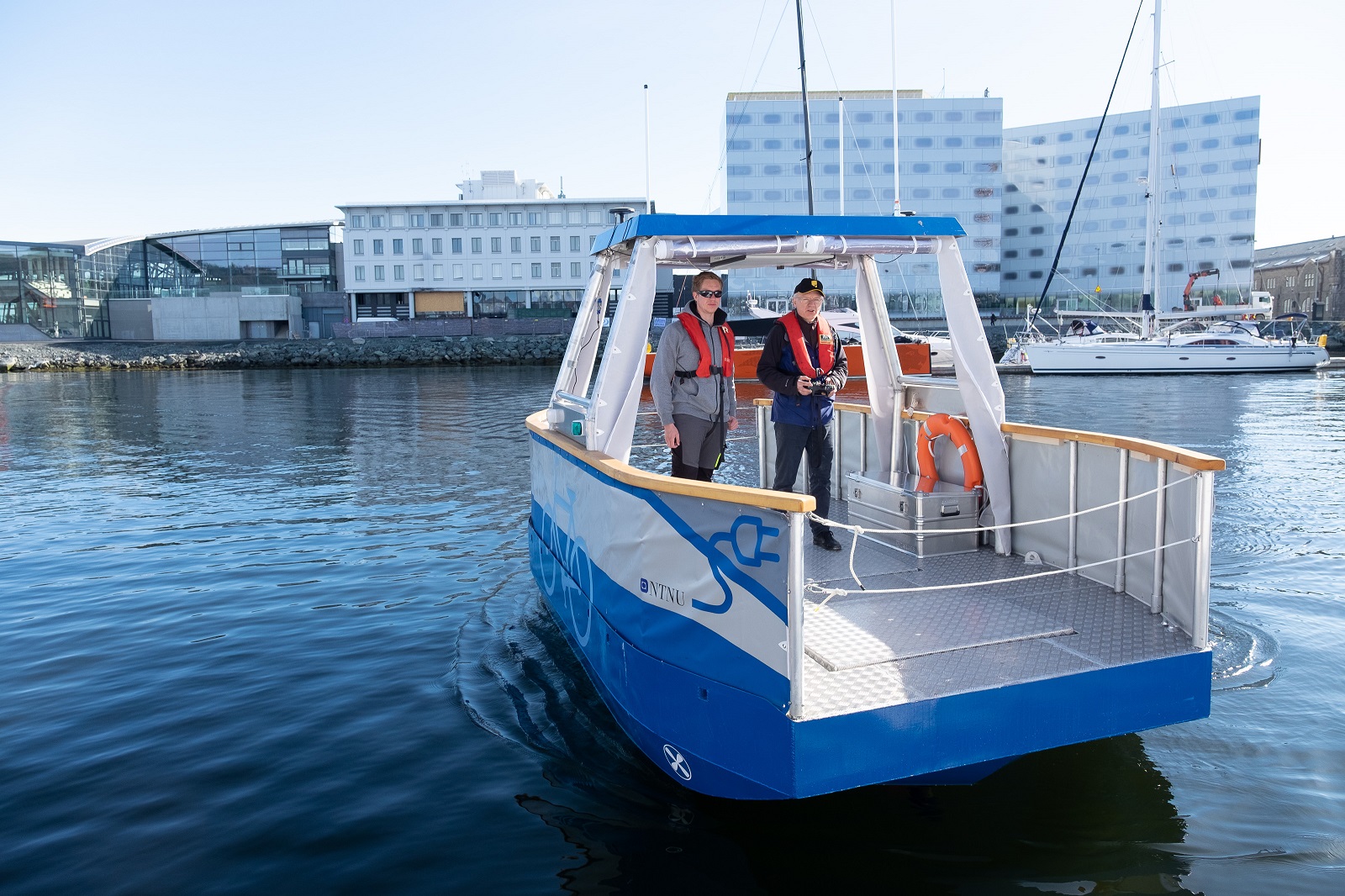Autoferry

The concept of small autonomous passenger ferries in urban areas is a more flexible and environmentally-friendly alternative to bridges or manned ferries. Autoferry therefore aims to develop groundbreaking new concepts and methods which will enable the development of such ferries for urban water transport. NTNU has recently developed a 5-m long (1:2 scale) prototype of an autonomous all-electric passenger ferry which will be used as the main experimental platform in the project. Succeeding with the Autoferry project requires a broad multi-disciplinary approach and therefore involves six PhD positions.
Autoferry is one of the nine NTNU Digital Transformation projects.
Project description

The main goal is to develop groundbreaking new concepts and methods to enable the development of autonomous passenger ferries for environmentally friendly and flexible transport of people in urban water channels.
The project will bring digital transformation both to urban water transport in particular and the maritime industry in general. It will develop and utilize digital technologies to significantly move the research frontiers required for autonomous ships; it will make NTNU attractive as a key partner for enhancing the competitiveness for emerging industries within the transportation of people at sea; and it will contribute to making Norway a prominent provider of transformative maritime transportation technology for the international market.
PhD projects
The main hypothesis is that autonomous passenger ferries can operate safely alongside other vessels in confined and congested environments such as urban water channels. Verifying this requires a broad multi-disciplinary approach, where the research methods combine theory, simulations and experimental testing and validation.
Hence, the project is divided into 6 main research areas:
- Automation and autonomy
- Multi-sensor tracking via shore- and ferry-based sensors
- All-electric power and propulsion
- Human factors, remote monitoring and control
- Communications and cyber security
- Risk management
Research goals
Corresponding to the six main research areas, six main research goals have been formulated, as achieving:
- A safe and precise crossing of the city canal in Trondheim using an integrated automation and autonomy system
- A multi-sensor target tracking system which provides reliable situational awareness, consisting of both on-shore and on-board sensors
- A digitized all-electric power and propulsion system with rapid charging
- Safe and efficient human-machine interaction between the autonomous ferry and its environment, including remote operators, passengers and other vessels
- A secure and reliable communication and navigation system
- A novel risk management framework tailored to autonomous passenger ferries
List of publications, Autoferry
- Ø. K. Helgesen, E. F. Brekke, H. H. Helgesen, and Ø. Engelhardtsen. “Sensor Combinations in Heterogeneous Multi-sensor Fusion for Maritime Target Tracking”, in Proceedings of 22nd International Conference on Information Fusion, Ottawa, Canada, 2019
- N. P. Reddy, D. Pasdeloup, M. K. Zadeh, and R. Skjetne. “An Intelligent Power and Energy Management System for Fuel Cell/Battery Hybrid Electric Vehicle Using Reinforcement Learning,” 2019 IEEE Transportation Electrification Conference and Expo (ITEC), 2019.
- N. P. Reddy, M. K. Zadeh, C. A. Thieme, R. Skjetne, A. J. Sørensen, S. A. Aanondsen, M. Breivik, and E. Eide. “Zero-emission autonomous ferries for urban water transport,” in IEEE Electrification Magazine, Dec 2019.
- T. Porathe, Ø. Rødseth, K. Fjørtoft, Å. Hoem & S. Johnsen. “At least as safe as manned shipping? Autonomous shipping, safety and “human error””. In Safety and Reliability – Safe Societies in a Changing World. Proceedings of ESREL 2018, June 17-21, 2018, Trondheim, Norway. Taylor & Francis 2018, ISBN 9781351174657. pp. 417- 425
- T. Porathe. “Maritime Autonomous Surface Ships (MASS) and the COLREGS: Do We Need Quantified Rules Or Is “the Ordinary Practice of Seamen” Specific Enough?” International Journal on Marine Navigation and Safety of Sea Transportation, 13(3), 511-517, 2019.
- T. Porathe. “Safety of autonomous shipping: COLREGS and interaction between manned and unmanned ships”. In M. Beer and E. Zio (Eds.) Proceedings of the 29th European Safety and Reliability Conference (ESREL 2019).
- T. Porathe. “Interaction Between Manned and Autonomous Ships: Automation Transparency”. International Conference on Maritime Autonomous Surface Ships, Busans, Korea, November 7. 2018 SINTEF proceedings.
- T. Porathe. “Autonomous ships and the COLREGS: Automation Transparency and Interaction with Manned Ships”. 18th International Conference on Computer and IT Applications in the Maritime Industries - COMPIT’19, 2019.
- A. Amro, V. Gkioulos, and S. Katsikas. "Connect and Protect: Requirements for Maritime Autonomous Surface Ship in Urban Passenger Transportation" 5th Workshop On The Security Of Industrial Control Systems and Cyber-Physical Systems (CyberICPS 2019). 2019.
Key scientists
-
Edmund Førland Brekke Professor
+47-73594382 edmund.brekke@ntnu.no Department of Engineering Cybernetics -
Egil Sverre Eide Associate Professor
+47-73594310 +4741691512 egil.eide@ntnu.no Department of Electronic Systems -
Sokratis Katsikas Professor
+47-61135258 +4791138581 sokratis.katsikas@ntnu.no Department of Information Security and Communication Technology -
Thomas Porathe Professor emeritus, Interaction Design
+46706681819 thomas.porathe@ntnu.no Department of Design -
Mehdi Zadeh Professor
+47-73413202 +4745089831 mehdi.zadeh@ntnu.no Department of Marine Technology
Project PhDs
-
Ahmed Walid Amro Postdoctoral Fellow
+4740492513 ahmed.amro@ntnu.no Department of Information Security and Communication Technology -
Øystein Kaarstad Helgesen
oystein.k.helgesen@ntnu.no Department of Engineering Cybernetics -
Namireddy Praveen Reddy PhD candidate/Research fellow
+4796710144 namireddy.p.reddy@ntnu.no Department of Marine Technology -
Dag Rutledal Associate professor
+47-70161634 +4793411085 daru@ntnu.no Department of Ocean Operations and Civil Engineering -
Emil Hjelseth Thyri
emilthyri@gmail.com Department of Engineering Cybernetics
